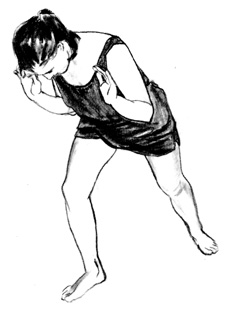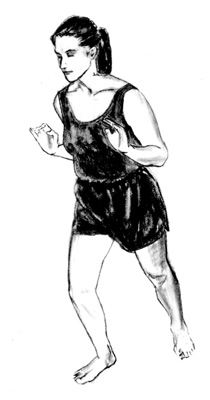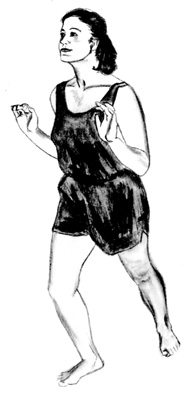The Enneagram of the Body
An Interview with Alan Sheets
by Jerome Freedman, Ph. D.
©Alan Sheets & Barbara Tovey 1995
REPRINTED FROM THE ENNEAGRAM MONTHLY AUGUST - NOVEMBER 1995
PART III
TYPES 1, 7 & 5
This is Part III of the "Enneagram of the Body", a series of articles about the inherently different bodily expression in each of the enneagram types. Barbara Tovey and I have been working together on this hypothesis. We have cataloged how this bodily expression indicates a unique type-specific ability to take in and process information about the world. In this article we will be discussing types 1, 7 and 5. The energy for each of these three types originates in the brain. 1, 7 and 5 all have an ability that is directly associated with a specialized reasoning process.
A NOTE ABOUT BRAIN TYPES
We use our brains all of the time and we are quite comfortable with the idea that the brain is what allows us to be human. So what does it mean to be a brain type? Does it mean that the brain types are somehow more advanced, i.e., higher functioning than the other types? No...however, what seems to be true is that the brain types have a more highly developed ability in a particular aspect of the brain's great processing power. The unique ability of each of these three types involves a very specialized kind of mental analysis. In addition, 5, 7 and 1 have a fundamentally different focus than the other six types. 8, 4 and 2, which are associated with the abdomen, deal directly with human interaction. 6, 3 and 9, which are associated with the sternum, deal directly with the process of how we do what we do. 8, 4, 2 and 6, 3, 9 all have to do with a very specific aspect of interacting with the world in the present time. 1, 7 and 5, however, are thinking oriented. They gather information from the world and then step back to analyze what they have found; they are the only types who need time to accomplish their specialized function. This adds a step which, for at least part of the time, takes the brain numbers out of the direct experiential loop.
THE INTERVIEW (continued)
Jerome Freedman: Lets continue! We've talked about types 8, 4 and 2. Would you give us a description of 1, 7 and 5 for Part III of this series?
5
 Alan
Sheets: Type 5 is energetically receptive. Although it is a brain type
like 1 and 7, none of the brain types uses any conscious brain activity
when they are accessing their skill or strength.
Alan
Sheets: Type 5 is energetically receptive. Although it is a brain type
like 1 and 7, none of the brain types uses any conscious brain activity
when they are accessing their skill or strength.
For the 5, this brain activity is very much like working a jigsaw puzzle. Imagine you have partially completed a jigsaw puzzle and can therefore have somewhat of an idea of what the next piece might look like. You then go searching for that piece. The information you have allows you to quickly and effortlessly ignore all of the pieces that do not look like they are going to fit. The 5 does the same thing. He or she has a sense of what is missing. They know when information which would enable us to gain a more complete understanding of whatever we are looking at is missing. That is why the relevant piece just pops out at them when they finally find it.
This is what uniquely gives the 5 the perspective of an overview. They are able to "map" all of the important and relevant pieces of information pertinent to a correlated and comprehensive understanding of our reality. With the identifications, simplifications and generalizations which 5s provide, our world view becomes more complete and easier to understand.
Randolph Nesse, M.D., and George Williams, Ph.D., state in their book, Why We Get Sick (pg. 134), "Our ancestors of ten thousand or perhaps even fifty thousand years ago looked and acted fully human. If we could magically transport babies from that time and rear them in modern families, we could expect them to grow up into perfectly modern lawyers or farmers or athletes or cocaine addicts." This implies that the way we view the world is a consequence of learning the current socially constructed order.
All the types, except 5s and 1s, assemble the world through this filter alone. Everything we think about is colored by the way we were taught to view the world. This goes a long way to explain, for example, why there are frequently such large differences between the generations (the "baby boomers" can never fully relate to the people who were "depression babies," etc.) 5s, by the nature of their enneagram skill, can look at the social order from a much more objective point of view. At some deep level they know that the map which they are working on is a construct that helps explain and justify our existence. They can see its weaknesses and strengths. They know it will change with time so they are not as wedded to it as other numbers. When they see a glaring problem they frequently try to get the word out.
The following is a good example of the 5's understanding of what is important: Dr. Linus Pauling, a type 5, made an interesting observation which led us to a very important understanding of the consequences of our human actions. He was one of the first people to grasp that any nuclear test which even slightly increased the amount of radiation exposure in humans would have serious health consequences for some people. Up until that time, people believed that if a nuclear test was conducted far from populated areas, people would not be affected by the radiation. They did not consider that if the overall planetary radiation level went up, certain susceptible people would be at risk, ultimately increasing the morbidity and mortality rates. Dr. Pauling felt so strongly about this that he used his great scientific influence to publicize these findings. He received the Nobel Peace Prize in 1962 for his research in this area and for his part in the formation of the Nuclear Test Ban Treaty. (This was his second Nobel Prize, having won the Chemistry Prize in 1954, becoming the only Nobel Laureate to ever win 2 unshared prizes.) Ironically, because of winning the 1962 Nobel Peace Prize, he was branded as a communist and removed as Chairman of the Chemistry Department at Cal Tech. At that time, his line of thinking was so new that people could only put it into a social context, hence the idea that he must not have the best interest of this country at heart.
7
 7s
are energetically pro-active. Energy emanates from the center of their
foreheads. 7s actively scan their environment for any potentially useful
information. They are continually gathering data, piecing it together and
applying it to whatever has their interest. Their focus doesn't come from
a desire to create an understandable overview by identifying the important
pieces in the map, as for the 5. Rather, they have this tremendous mental
skill which allows them to put information to practical use in new and
creative ways.
7s
are energetically pro-active. Energy emanates from the center of their
foreheads. 7s actively scan their environment for any potentially useful
information. They are continually gathering data, piecing it together and
applying it to whatever has their interest. Their focus doesn't come from
a desire to create an understandable overview by identifying the important
pieces in the map, as for the 5. Rather, they have this tremendous mental
skill which allows them to put information to practical use in new and
creative ways.
7s see possibilities and correlations that the rest of us frequently miss. If you want to know the best way to do something, ask a 7. I have a 7 friend who was thinking about buying a house. From a buyer's point of view, she gave me a clearer, more cogent explanation of the ins and outs of buying a house than the several real estate agents I know...and, she'd only spent a month playing with it!
A tremendous problem solving ability gives 7s a level of self confidence when dealing with the unexpected which the rest of us lack. The world is ever-changing and no matter how much we try to foresee our future, it usually turns out differently than we've anticipated. Their problem solving skill helps prevent 7s from becoming stuck or mired in difficult situations. They do not dwell on the past or their failures as much as the other types because they're more apt to find a solution to their problem.
One of my 7 acquaintances, who owns a collection of cars, a truck and an airplane, had driven his 1 1/2
ton diesel pickup truck from San Diego to Arizona to get it rebuilt (because it was cheaper in Arizona!). Once it had been rebuilt he picked it up one evening and began driving it to his home in San Francisco. It broke down 20 miles into his trip. He was able to convince the mechanics to come out and fix it in the dark. Later on, in the dead of night, alone and in the middle of the desert, the injector plugs fouled and the engine died. He did not have the appropriate tools with him to make repairs. At this point many of us would have given up . . . but all his friends know that for him, the bigger the challenge, the more he likes it! He had a pair of metal shears with him and with them he fashioned a wrench out of a piece of sheet metal. Then, with a flashlight held in his teeth, using the tool he had made, he took the injector plugs out, cleaned them off with the only fluid available - starter fluid - and then replaced the injector plugs. All in all, he arrived home many hours later than planned, exhausted and kicking himself for not rebuilding the truck himself (he has a spectacular tool collection), but proud of himself for how he solved this problem. He's known as "McGuyver" by all of his friends! (McGuyver was a popular TV show about a clever person who, on each show, would get himself out of seemingly impossible and life threatening situations using great ingenuity.)
1
 The
1 is a combination of receptive and pro-active energy which also emanates
from the brain. 1s receptively take in the world with their eyes and filter
it through their old or reptilian brain where the wisdom of our successful
social survival is stored. They pro-actively project this ancient understanding
out the throat just above their Adams apple. The 1 is one of only three
types (1, 2 & 3) who need to look into the facilitator's eyes to access
their strength.
The
1 is a combination of receptive and pro-active energy which also emanates
from the brain. 1s receptively take in the world with their eyes and filter
it through their old or reptilian brain where the wisdom of our successful
social survival is stored. They pro-actively project this ancient understanding
out the throat just above their Adams apple. The 1 is one of only three
types (1, 2 & 3) who need to look into the facilitator's eyes to access
their strength.
The 1's focus is survival. Not just personal survival, but survival of the species. We are an advanced and interdependent social species. Our social order is very complicated and ever-changing. 1s gather the information about the underlying principles of our social order and compare it to the genetically stored wisdom of the old brain. With this additional insight they can provide us with the knowledge, wisdom, understanding and direction to help enable us to survive into the future. If you ask a 1 about how they look at it, they tend to describe it as a sense or awareness that each and every situation has a structure, reason and purpose, governed by appropriate rules, and that these rules are like the grease which helps keep the wheels of society turning.
My wife's mother is a 1, and once when we were in a restaurant together, our 1 1/2 year old daughter kept trying to climb up on the table. We told her three or four times to stop, but she kept doing it. Barbara's mom said, "Jenna, I want to show you something . . . I want to show you what the other children in the restaurant are doing . . . let's go around the room so we can see what the Moms and Dads and other children are doing." Then she carried her about and pointed out the waiters who were carrying food to serve, and talked to her about the parents and kids who were sitting down because they were hungry and wanted to eat their meals. When they returned, not only had they had a wonderful time together, but Jenna stopped climbing up on the table. Barbara and I would never have thought of doing something like that. It was simply a way of teaching our daughter about restaurant structure and about the rules we follow in order to enjoy a meal.
One of the qualities that is universally observed when talking with 1s is their sense of self assuredness about the way things ought to be. When interacting with 1s, we get a feeling that they know they are right in a way that we do not sense in any other type. It is as though they're following a script that the rest of us not only don't have, but don't even know exists. This is because they are able to access understanding that is stored in deep genetic memory which deals with our survival. They know in the core of their being that if we do not function within the appropriate structure, we run the risk of creating problems that could ultimately lead to our extinction as a species. This may be a strong statement, but if we look at the way people are relating on this highly overcrowded planet, we get an inkling about how important it is to make society work. This is not to say that people ought to have altruistic motives, but that we must recognize that it is in our own best interest to promote our survival by safeguarding the parameters of the social order.
ABOUT THE AUTHOR
Jerome Freedman, Ph. D., Certified Teacher of the Enneagram in the Oral Tradition with Helen Palmer, practices in Marin County, California. In addition to enneagram work, mind stories, and Buddhist meditation, he is a highly trained and experienced computer consultant with many clients in Fortune 500 companies. Questions and comments are welcome.
email - jerome@enneagram-instrument.org
phone - 415-461-6476
mail - PO Box 665
Larkspur, CA 94977
Alan Sheets & Barbara Tovey
email - AlanS31416@AOL.COM
phone - 415-459-6796
mail - 1330 Lincoln Ave., Ste. 202
San Rafael, CA 94901
ENNEAGRAM MONTHLY
e-mail - ENNEAMONTH@AOL.COM
phone - 518-279-444
mail - 117 Sweetmilk Rd.
Troy, NY 12180
When we reprinted these articles, we updated them to reflect our current understanding of this work. We made every effort to keep the flavor, the integrity and the flow the same as it was in the originals.
Alan Sheets and Barbara Tovey
11-96
Related offer!
{$offer['title']}
